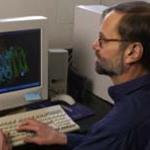
Education History
Ph.D.: The Ohio State University, 1975 (E.L. Gross)
Postdoctorals: Purdue University (R.A. Dilley); University of Oregon (R.A. Capaldi)
Research Statement
Our laboratory studies the biochemistry and molecular biology of membrane-bound enzymes that are crucial in heart and bacterial energy conservation reactions. Our research focuses on structure/function relationships in heart mitochondrial and thermophilic bacterial cytochrome c oxidases, using immunological, biochemical, and recombinant DNA methods. Cytochrome c oxidase is the terminal member of the respiratory chain of the mitochondrion and some aerobic bacteria. The enzyme contains hemes and copper atoms that act as oxidation-reduction centers. In the terminal electron transfer reaction catalyzed by the enzyme, molecular oxygen is reduced into water and the energy released by these oxidation-reduction reactions is conserved by the pumping of protons across the mitochondrial inner or bacterial cell membrane. The electrochemical gradient generated by the enzyme is subsequently used to drive the synthesis of ATP. The cytochrome c oxidases are multi-subunit enzymes containing from 13 subunits in the mammalian mitochondrial form to 3-4 subunits in the bacterial forms. The three largest subunits are conserved between the mitochondrial and bacterial forms. The two largest subunits contain the redox centers of the enzyme and most likely contain the proton-pumping function of the enzyme.
Our work has focused on the role of the highly conserved, non oxidation-reduction center containing third subunit (subunit III) in the functioning of bovine heart mitochondrial cytochrome c oxidase. Toward this goal, we have studied a preparation of the mitochondrial enzyme that is depleted in subunit III and found that this enzyme has lost 50% of its energy transducing or proton pumping function by an unknown mechanism. Addition of purified subunit III to subunit III-depleted enzyme results in a stimulation of proton pumping in the enzyme. We also have made site-specific antibodies to the hydrophilic domains in subunit III and have observed that these antibodies stimulate electron transfer activity of the enzyme without affecting proton-pumping. Our results (and those from other laboratories) suggest that subunit III regulates cytochrome c oxidase activities.
Currently, we are studying the role of critical conserved amino acids in subunits III and I in the functioning of the bacterial enzyme in Rhodobacter sphaeroides. In one collaborative project (with J. Hosler), we are mutating the amino acids at the interface of subunits III and I to investigate the effect of the mutagenesis on the functioning of the enzyme. In another collaborative project (with R. Gennis and D. Zaslavsky), we are attempting to measure the proton-pumping stoichiometries during the enzyme's oxidase and peroxidase catalytic activities.
Another interest in our laboratory is whether mitochondrial cytochrome oxidase functions as a monomeric unit or dimeric form within the mitochondrial inner membrane in vivo. We have shown by using heterobifunctional chemical crosslinking reagents that subunit I forms a contact site for two monomers of the enzyme. Furthermore, our work has shown that the dimeric structure is preferred in a membrane bilayer environment. We are currently preparing artificial membranes (liposomes) that contain either one or two cytochrome oxidase molecules per liposome to explore the possibility that monomers or dimers of the enzyme have different functional activities.
Other interests in the laboratory include integral membrane protein-lipid interactions and the interactions of detergents with membrane proteins. We also focus much of our research efforts on the reconstitution of membrane proteins into artificial membranes (or liposomes) and the development of assays to assess protein incorporation into membranes.
We have used a battery of techniques in our investigations, including membrane protein isolation, preparation and characterization of liposomes, chemical modification of protein functional groups using group specific reagents, and production and characterization of site-directed and subunit-specific antibodies.
People:
- Lawrence J. Prochaska, Ph.D., Principal Investigator
- Christine N. Pokalsky, Ph.D., Research Associate
Publications
1. Prochaska, L. J., and Cvetkov, T. The Mitochondrial Respiratory Chain, Encyclopedia of Biophysics, European Biophysical Societies, (V. Davidson, editor) Springer, New York, (2013) Vol. 3, pp 1539-1544.
2. Rubinson, K.A., Pokalsky, C, Krueger, S. and Prochaska, L. J., Functional Native Beef Heart Mitochondrial Cytochrome c oxidase Forms Dimers in Lipid Bilayers: The Structure by Small-Angle Neutron Scattering (SANS). The Protein Journal (2013) 32:27–38.
3. L. Prochaska, S. Berberich, B. Roman, D. Parmelee, P. Hudes, A. Bell, B. Binder, A. Burke, A. Deardorff, K. Oxner, A. Fernandes, S. Neeley, P. Koles, J. Pearson, S. Poznanski, Evolution and Revolution in the Curriculum at Boonshoft School of Medicine, Wright State University, MedED Portal (2013) https://www.mededportal.org/icollaborative/resource/839
4. Alnajjar, K.S., Hosler, J.P., Prochaska, L.J., The Role of the N-Terminus of Subunit III in Proton Uptake in Cytochrome C Oxidase of Rhodobacter sphaeroides, Biochemistry (2014) 53(3):496-504.
5. Alnajjar, K.S., Cvetkov, T.L., Prochaska, L.J. The Role of Phospholipids of Subunit III in the Regulation of Structural Rearrangements in Cytochrome c Oxidase of Rhodobacter sphaeroides, Biochemistry (2015) 54:1053-1063.
